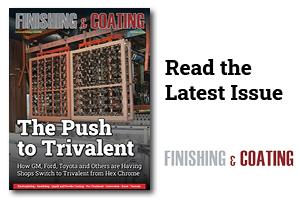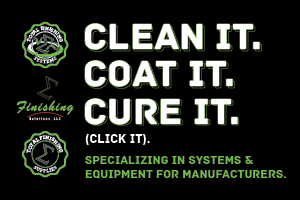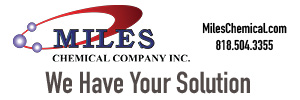As 2025 begins, James Simonelli has only one goal regarding the metal finishing industry and government regulations.
 James Simonelli“We must lead the fight and not just react to it,” says Simonelli, the California Metals Coalition executive director (CMC). “The time is now to collaborate with those leaders in the metal finishing industry who are ready to execute big plans and produce real results.”
James Simonelli“We must lead the fight and not just react to it,” says Simonelli, the California Metals Coalition executive director (CMC). “The time is now to collaborate with those leaders in the metal finishing industry who are ready to execute big plans and produce real results.”
For over 50 years, the CMC has united different sectors of California’s metal industry into a flourishing coalition. That group includes hundreds of metal foundries and die casters, machine shops, forgers, heat treaters, metal stampers, metal formers, galvanizers, recyclers, shredders, and a growing number of finishers.
Taking Up Cause of the Metal Finishing Industry
Lately, the CMC has worked even closer with the metal finishing industry in California. Regulators are mounting pressure on the industry regarding using hexavalent chromium (Cr6) in surface finishing. In 2024, the California Air Resources Board (CARB) imposed strict new rules against finishers that will effectively force the closure of many chromium-using metal finishing operations. The CMC cited outdated science as the basis for its decisions.
That raised the awareness of CMC members, who fear that losing a major part of the metal finishing industry due to unfair regulatory scrutiny will hurt their businesses, too, as metal finishing is a critical part of the manufacturing process.
“It's self-serving in certain ways because if the finishers get attacked and lose, it takes away our member’s ability to send products close to get it finished,” Simonelli says. “And then secondly, other industries might get hit with the same issues that the metal finishers were hit with.”
While the Metal Finishing Associations of California (MFACA) —both the Northern and Southern chapters, which represent hundreds of shops in the state—fought the new CARB rules at various hearings, they did so with insufficient scientific evidence to back up their claims that hexavalent chromium was not a threat to worker safety with all of the protocols and equipment that many shops have installed over the past decades.
“This is just a tremendous breakthrough in this fight,” Simonelli says of the new study that CMC has spent almost $1 million on.
Along with the limited data, they were left with having workers from various shops testify at variance hearings, saying they felt safe working in metal finishing operations and providing anecdotal and emotional testimony that ultimately didn’t sway board members voting on the measure.
Creating Scientific Documentation Challenging Claims
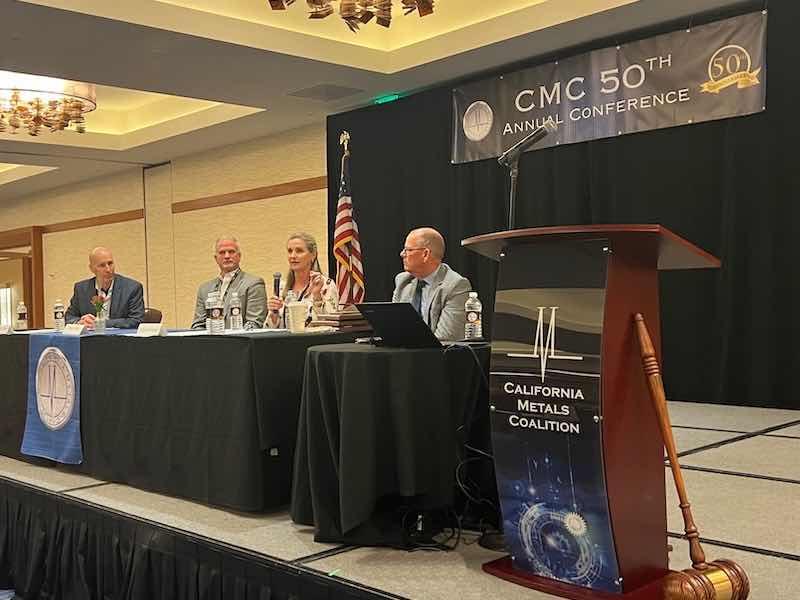 Deborah Proctor of ToxStrategies speaking on a panel at the CMC 50th Anniversary Annual Conference in Anaheim.But Simonelli and CMC are out to change that. Led by its Board of Directors, CMC is funding a nearly $1 million study that examines large numbers of employees across the U.S. who have been exposed to hexavalent chromium in the workplace. More importantly, the study includes worker exposure to low levels of hexavalent chromium, rather than previous studies that have only analyzed worker exposure at very high levels of hexavalent chromium.
Deborah Proctor of ToxStrategies speaking on a panel at the CMC 50th Anniversary Annual Conference in Anaheim.But Simonelli and CMC are out to change that. Led by its Board of Directors, CMC is funding a nearly $1 million study that examines large numbers of employees across the U.S. who have been exposed to hexavalent chromium in the workplace. More importantly, the study includes worker exposure to low levels of hexavalent chromium, rather than previous studies that have only analyzed worker exposure at very high levels of hexavalent chromium.
In 2020, CMC took the nation’s first step to study the low-exposure inhalation cancer risk factor for hexavalent chromium by funding a study led by Dr. Loren Lipworth, the Division of Epidemiology of Vanderbilt University, biomathematician Bruce C. Allen, and ToxStrategies, a scientific consulting firm.
In 2024, Dr. Lipworth and others submitted two papers on the study to the Journal of Occupational and Environmental Hygiene (JOEH) for review and publication. On January 8, 2025, JOEH approved the first of the two papers for publication, which can be read at https://www.tandfonline.com/doi/full/10.1080/15459624.2024.2439817
“This is just a tremendous breakthrough in this fight,” Simonelli says.
Evaluating Thousands of Workers Exposed to Hexavalent Chromium
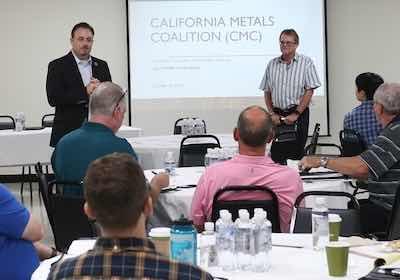 James Simonelli speaks to members of the metals industry on hexavalent chromium.The first paper, the “Burbank Cohort,” evaluates more than 3,700 workers exposed to Cr6 at the Lockheed Martin Burbank Aircraft Manufacturing facility from 1960 to 1992.
James Simonelli speaks to members of the metals industry on hexavalent chromium.The first paper, the “Burbank Cohort,” evaluates more than 3,700 workers exposed to Cr6 at the Lockheed Martin Burbank Aircraft Manufacturing facility from 1960 to 1992.
“No other cohort studied for risk assessment of Cr6 — including California’s current standard — has such a robust and diverse data set,” Simonelli says.
The second paper, “Combined Cohorts,” combines data sets from all other available studies in Painesville, Baltimore, and Burbank to establish the world’s most comprehensive dose-response modeling and risk assessment for Cr6 exposure. More importantly, it will use the low-exposure and high-exposure data to create a dose-response curve. Simonelli says JOEH reviewers are still analyzing the second paper and providing comments to the author.
Simonelli says the CMC hopes that these new scientific studies will allow them to petition CARB to recognize the new data and acknowledge the difference between the old data, which reference cancer risk based on high-level exposures to Cr6, and the new data, which analyze health risks based on low-level exposures to Cr6.
“When the metal finishing board was fighting this, we never saw the light at the end of the tunnel,” Guzman says.
He says having the studies, epidemiologists, toxicologists, and researchers show evidence that exposure to Cr6 in small quantities does not pose the same health risk and, therefore, does not warrant the same regulatory approach that could shut down much of the metal-finishing business in California.
“I think the last time around was a painful process to watch because the metal finishers just didn't have enough scientific evidence with them,” Simonelli says.
Metal Finishers Established “Blueprint” for Fighting Back
 Justin GuzmanHowever, he also credits the California finishing associations with devising a plan to combat the regulations that loom over them. In 2017, the metal finishers commissioned a paper to update the inhalation unit risk (IUR) for respiratory hexavalent chromium in California and sent it to the California EPA for consideration.
Justin GuzmanHowever, he also credits the California finishing associations with devising a plan to combat the regulations that loom over them. In 2017, the metal finishers commissioned a paper to update the inhalation unit risk (IUR) for respiratory hexavalent chromium in California and sent it to the California EPA for consideration.
The data references in the study were the foundation for CMC's research.
“They helped create that blueprint or the map to get us to do the fight,” Simonelli says. “But the problem is that you needed that mass of companies and the momentum to attack.”
Justin Guzman, President of Aircraft X-Ray, a large finishing operation in Huntington Park, is a board member of the Metal Finishing Association of Southern California and its former president. He is also a CMC board member and is thrilled that the organization is taking up the fight for metal finishers.
“When the metal finishing board was fighting this, we never saw the light at the end of the tunnel,” Guzman says. “We kept getting the runaround, and everyone we spoke with on the political side would listen and essentially say, ‘There is no science behind what you are telling us.’ And we just weren't big enough to fund this battle.”
The CMC decided to join the hexavalent chromium fight alongside the finishers in 2017 when an electroplating shop in Paramount, Southern California, was targeted for its chromium emissions. A CMC member across the street, Aerocraft Heat Treating, felt collateral damage.
Simonelli says a local air district installed an air sensor between the two shops and eventually pursued when hexavalent chromium and nickel levels were detected.
Updating Research with New Data
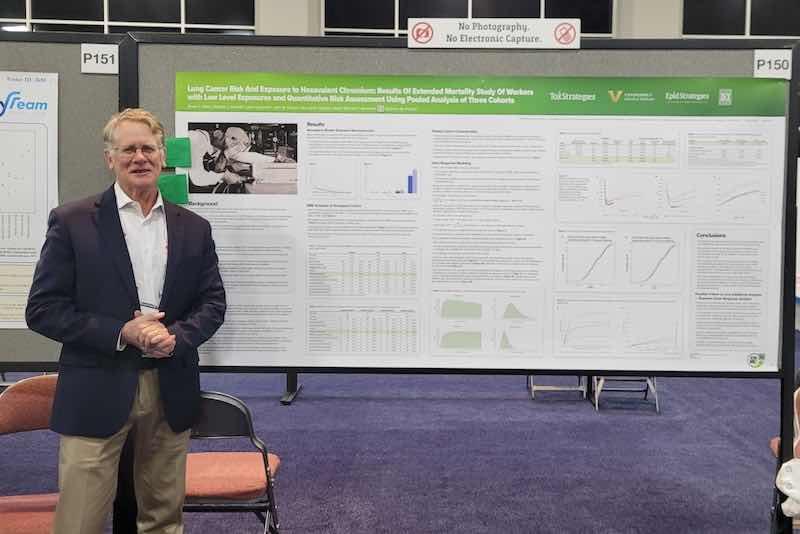 Bruce Allen presenting a poster on the Cr6 research at the 2024 Society of Toxicologists Conference in Salt Lake CityShortly thereafter, Simonelli read the 39-page metal finishers group paper on IUR. He was impressed with the robust references but felt that third-party experts needed to update it.
Bruce Allen presenting a poster on the Cr6 research at the 2024 Society of Toxicologists Conference in Salt Lake CityShortly thereafter, Simonelli read the 39-page metal finishers group paper on IUR. He was impressed with the robust references but felt that third-party experts needed to update it.
That is when CMC in 2019 hired ToxStrategies and KP Advocates to build upon the 2017 study and pursue data from a study on thousands of Lockheed Martin workers. CMC retained ToxStrategies as the lead on the researchers at a fee of $950,000 — the metal finishers in California contributed $50,000 — and used Vanderbilt’s Lipworth and expert Bruce Allen to do the research, which JOEH has approved for publication showing there is no evidence of workers getting sick from low-level exposures to hexavalent chromium.
That study will be important in California because, while the Federal OSHA’s Cr6 worker threshold is 5 micrograms/m³, Simonelli says local air districts in the state —such as CARB, Cal-EPA, and even the Federal EPA — are focused on the community inhalation cancer risk factor where a company can be deemed a community health risk at 1 nanogram/m³ of Cr6. The inhalation unit risk used to develop the 1 nanogram/m³ of Cr6 threshold has been used as the basis for local air district rules, Prop 65 enforcement, HRA changes, fines, CARB rulings, and third-party community group lawsuits.
Financial Resources Needed to Mount a Fight
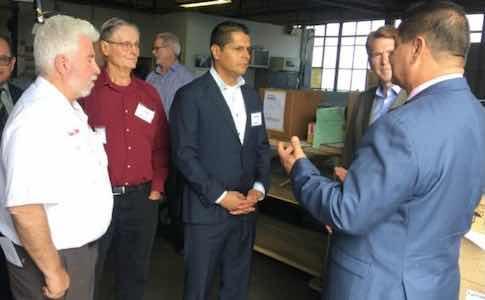 MFASC members have lobbied state legistlators for years on how they opetrate their shops. Aircraft X-Ray Laboratories hosted a fundraiser and tour for a candidate for California Assembly.However, Simonelli and the CMC Board of Directors knew they would need a lot of money to fight the necessary battle over Cr6.
MFASC members have lobbied state legistlators for years on how they opetrate their shops. Aircraft X-Ray Laboratories hosted a fundraiser and tour for a candidate for California Assembly.However, Simonelli and the CMC Board of Directors knew they would need a lot of money to fight the necessary battle over Cr6.
“ I went back to my members, and I asked some of them for $100,000 each,” he says. “I said, ‘We need you to raise a million bucks. I can't do it by $5,000 donations because we don't have enough members, so I needed some to write $50,000 to $100,000 checks. It was tremendous when those leaders stepped up.”
That is when the CMC members stepped up to fund the almost $1 million study, which presented actual scientific data on the low-level exposure risk factors.
“They all said, ‘We have to fight this,’” Simonelli says. “Credit should be given to the metal finishers for publishing that 39-page paper for calling out the state, but you can't pause at that point; you must take it to the next step.”
The publication of their study could not have come at a more crucial time. In August 2024, the U.S. EPA published the federal IRIS Toxicological Review of Hexavalent Chromium [Cr(VI)] CASRN 18540-29-9, which contains information about risks in drinking water and includes an analysis of workers exposed to hexavalent chromium by inhalation.
Guzman says he is thankful that CMC has access to the scientific data needed to possibly overturn some of the regulatory rulings made by CARB and other agencies.
”At this point with this study, we are going to put all our chips out on the table,” Simonelli says.
“I value the people who are the NASF and the support they are able to provide the metal finishing industry, but being a part of the CMC also means supporting my customers who are CMC members, and they are supporting me,” Guzman says. “California is my backyard, and I need to keep our businesses open and pay the bills.”
He and other MFASC members — including their northern chapter, the MFANC — work closely with NASF, as three California MFACA members are on the NASF national board.
“The NASF brings us their presence and muscle nationally and in Washington federally. It is a great combination,” Guzman says.
Concern that EPA Will Use California’s Standard for Inhalation
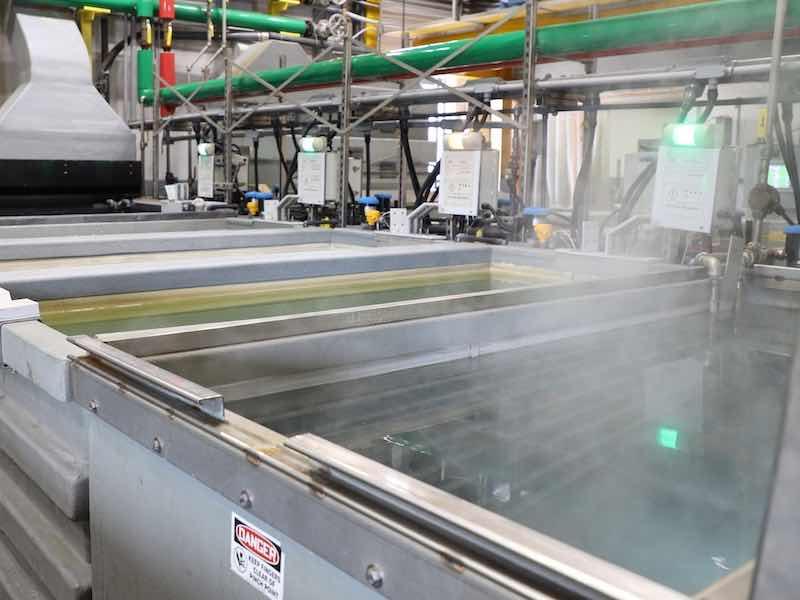 CMC is concerned that the U.S. EPA will use California’s standard as a new national basis for inhalation. In 2025, CMC is also preparing to ask other companies and organizations for more funding to continue the political—and potentially legal actions—needed to finish the job.
CMC is concerned that the U.S. EPA will use California’s standard as a new national basis for inhalation. In 2025, CMC is also preparing to ask other companies and organizations for more funding to continue the political—and potentially legal actions—needed to finish the job.
Simonelli and CMC — as well as the metal finishers that have become members of the CMC — are hoping that the release of their study in the national publication will help them in their fight to potentially reopen the CARB rules and thwart any further regulations that can not contradict their findings.
”At this point with this study, we are going to put all our chips out on the table,” Simonelli says. “The key point of this study is low exposure levels when all of the previous studies have been on people exposed to high levels of hexavalent chromium — hundreds of thousands of nanograms.”
Instead, the CMC study will show what truly happens when workers at manufacturing operations are exposed to low levels of exposure.
Demonstrating Low Levels of Exposure
The CMC hopes that one of the results is that California—which has not updated its cancer risk assessment in almost 50 years—might finally do so with this new research. They also hope that CARB will revisit some of its 2023 regulations after the CMC starts the petition process.
The CARB rules — which will phase out the use of hex chrome by chrome plating and chromic anodizing facilities, starting with its use for decorative purposes where it says safer alternatives are now available — are expected to go into effect as soon as 2027 and through 2039.
”The one thing that might save metal finishers and give them a little glimmer of hope is the enactment date,” Simonelli says. “When I talk to them about this study, some say, ‘The game's over for us.’ And I say the game is never over in politics. As long as you can change the regulation or amend the law, you are always in the fight.”






